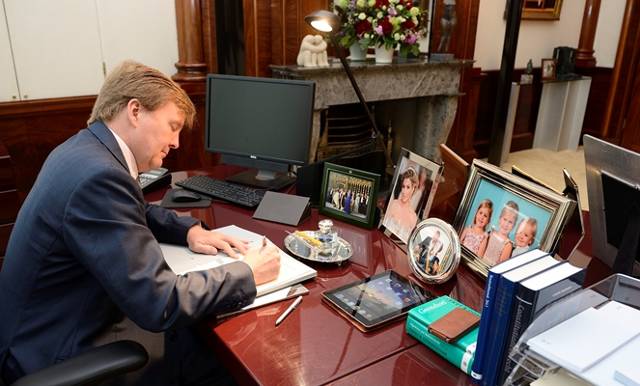Signing Acts of Parliament and Royal Decrees
Under the Constitution, before a bill can enter into law it must be passed by Parliament and then signed by the monarch and countersigned by the responsible minister or state secretary.

Every working day a number of state documents are submitted to the King for his signature, along with a briefing from the King’s Office on the substance, importance and background of each document.
Acts of Parliament and Royal Decrees must be signed by both the King and the responsible minister or state secretary before they can become law. By countersigning, members of the government confirm their acceptance of constitutional responsibility for the legislation.
Every year the King signs some 500 Acts and orders in council and some 3,000 Royal Decrees. All of them must be signed by the King in person. No one else may sign on his behalf.
If the King is abroad
Article 47 of the Constitution states that all Acts of Parliament and Royal Decrees must be signed by the King and by one or more ministers or state secretaries. The King’s Office submits these documents to the King on a daily basis and briefs him on their content.
All these documents must be signed by the King in person. No one may sign on his behalf as in the Dutch constitutional system he has no deputy. Consequently, even if the King is abroad documents urgently requiring a signature are sent to him.
Until 30 April 2013 the procedure when the monarch was abroad was as follows:
- The document to be signed was faxed (later emailed) to an official of the Queen’s Office on the spot.
- The official submitted the document for signature.
- The Queen signed the document.
- The official faxed or emailed the document back to the Netherlands.
- On her return to the Netherlands the Queen signed the original document, keeping the date of the first signature.
Present-day technology has made the role of the official redundant.
- The King’s Office can now submit documents urgently requiring a signature directly to the King by electronic means.
- The King appends a genuine signature to the document on his tablet.
- The King then sends the document back to the King’s Office by electronic means.
- The legislative process can then proceed using the document with its electronic signature.
- On his return to the Netherlands the King signs the original document, keeping the date of the first signature. This part of the procedure has not changed.
The new procedure was adopted with the agreement of the Minister of Justice and Security.